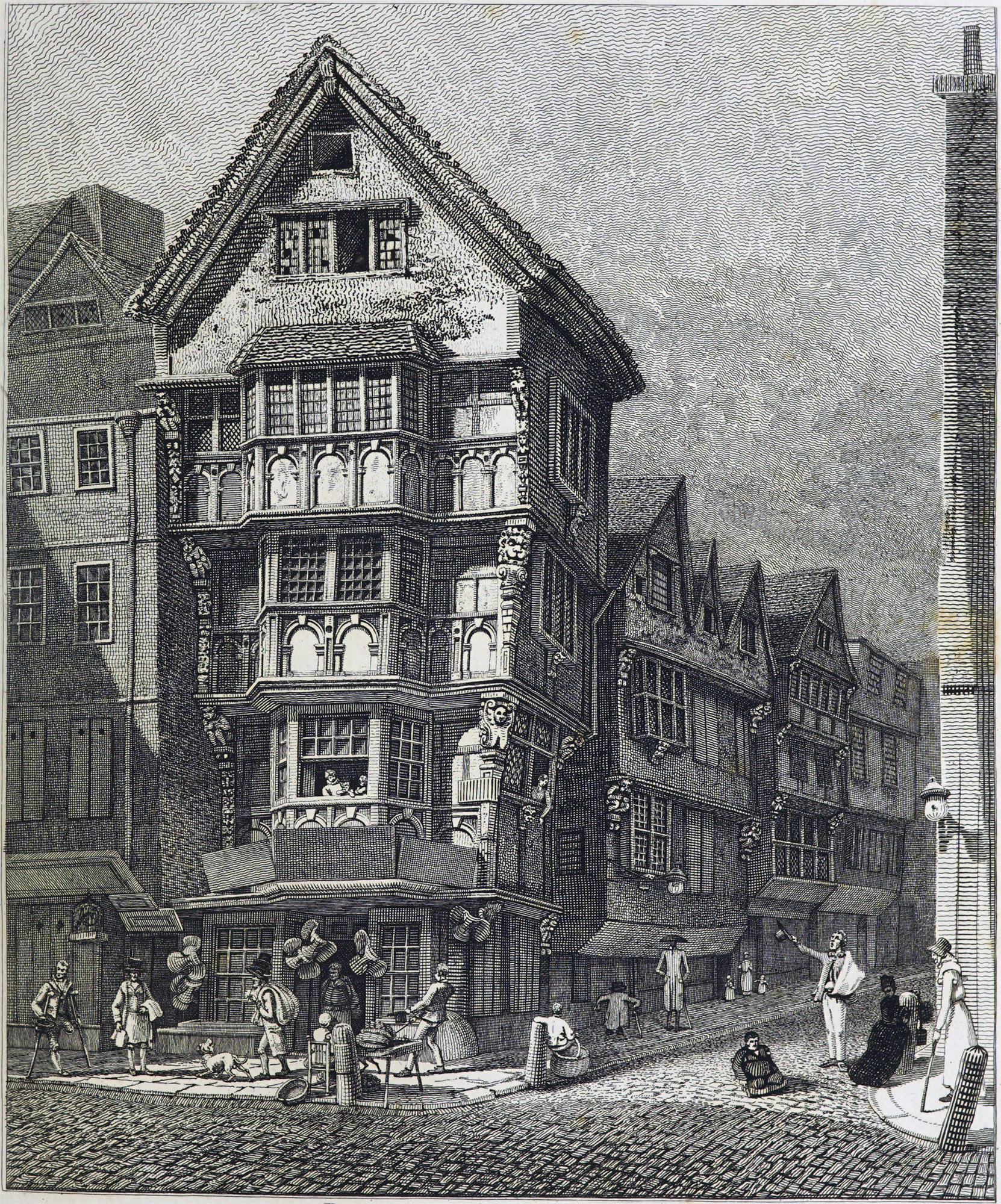
Houses Lately Standing on the West Corner of Chancery Lane, Fleet Street
by J.T. Smith
1789
The west corner of Chancery Lane, drawn in 1789 and published in Ancient Topography of London, by John Thomas Smith (London: J. M'Creery, published and sold by the proprietor, John Thomas Smith, etc., 1815) (facing page 48).
The caption under the illustration reads:
It was from the top of the corner house that several cherubs flew down, and presented Queen Elizabeth with a crown of laurels and gold, together with som verses, when she was going into the City upon a visit to Sir Thomas Gresham. The figures displayed in the work are all drawn from life and mostly from public characters.
External specimen of the grotesque bracketed front and projecting stories , of the reign of Edward VI. These houses were taken down by the City in May 1799 to widen Chancery Lane. They were entirely of oak and plaster.
From the text:
The greater number of persons now living, must recollect this very singular house. It was of oak, lath, and plaister; and consisted of five sets of apartments, with the addition of a loft. These rooms increased in length and breadth, as they ascended from the street, so that every story, becoming larger upwards, rendered the attic considerably larger than the ground floor. This ancient, and once fashionable, mode of building, appears in direct opposition to common sense. Many such houses were erected on either side the streets, from Temple Bar to Whitechapel, as may be seen in the old engravings of Cheapside and Cornhill; particularly in those of the processions of Edward the Sixth, and Mary De Medici. In that part of Fleet-street, from Temple Bar, to the distance of three houses on its South side, beyond St. Dunstan's Church, one of the spots where the fire of London stopped, there were many, and indeed, there are now several, to be seen. Many are also remaining in Leadenhall-street, from Leadenhall to Whitechapel; for it must be recollected, that all the houses, from the third house from St. Dunstan's Church abovementioned, to Leadenhall, (or indeed where Leadenhall stood, it being now entirely taken down,) have been erected since the great fire of 1666; and it appears from the date 1667, cut on the front of a house, in the Poultry, occupied by Messrs. Phillips and Hingston, Chemists, that that part was one of the first finished after the conflagration. The ceilings of this house which probably had once been decorated, were quite plain. It was taken down in May, 1799. The following notice of it appeared in the "Morning Herald," May 20th, 1799:
"The house in Fleet-street, which the City is now pulling down to widen Chancery Lane, is the oldest in that Street, being built in the reign of Edward the Sixth, for an elegant mansion, long before there were any shops in that part of the City. It was from the top of this house, that several cherubs flew down, and presented Queen Elizabeth with a crown of laurels and gold, together with some verses, when she was going into the City, upon a visit to Sir Thomas Gresham. It was the contrivance of the Students of the Temple; and the accounts in the books of that day, say 'the Queen's Highness was much pleased therewith.'—The fourth cherub says:
"Virtue shall witness of her worthyness,
And fame shall registrate her princelie deeds.
The world shall still praie for her happiness;
From whom our peace and quietude proceeds."As the building just described was so near to Temple-Bar; I trust the Reader will pardon the introduction of the following extract, taken from Queen Elizabeth's Progresses, Vol. i. p. 22, as it may throw some light on a subject, concerning which we find so little information in the London Historians.
The Author describing the procession of Her Majesty, on the 13th of January, 1558, the day before her coronation, says,
"From thence her Grace came to Temple-Barre, which was dressed fynelye with the two " ymages of Gotmagot the Albione, and Corineus the Britain, two gyantes bigge in stature, furnished accordingly; which held in their handes, even above the gate, a table whering was written, in Latin verses, theffet of all the pageantes which the citie before had erected."
Possibly these very figures, provided by the City, might have been the originals of those described by Strype in his edition of Stowe's Survey of London, as an ancient Briton and Saxon, then standing in Guildhall. (48-9)
This image is in the public domain.